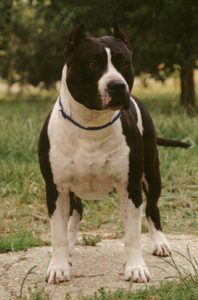
My name is Gabor Hamza. We are involved in this breed with my
friends since 1994. We live in Hungary in the central of Europe.
-Our first litter was out in 1997. You cann find more inform and
pictures on "Gallery" page.

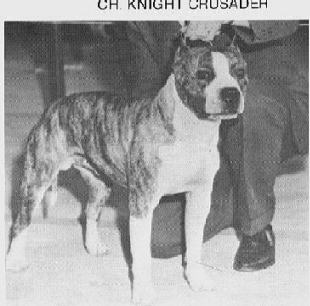
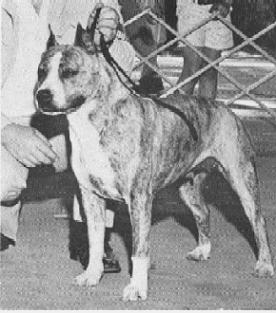
Ch. Knight's Crusader
Ch. Sindelar's Heidi Ho
The ancestors of this terrier were originally bred in England to be
canine gladiators when dogfighting and bullbaiting were in fashion.
Over the past half-century, careful breeding in the United States has
produced a dog that is affectionate, reliable and good with children.
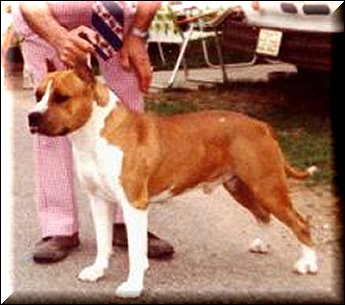
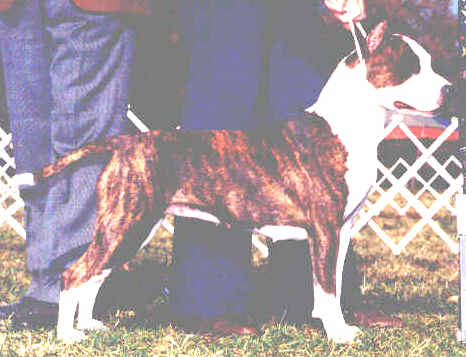
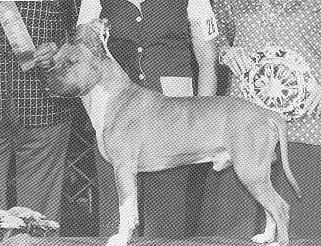
Ch. Fraja EC Winning Ticket Ch. Ruffian Red
Rock of Har-Wyn
Although fighting tendencies have been bred out, the American
Staffordshire Terrier should present a strong, fit, athletic
appearance. The Am Staff's short, glossy coat comes in a variety of
colors from cream to black. With a little training this breed is good
with other dogs. The Am Staff is a happy, outgoing,stable and
confident animal who makes a wonderful family pet.
![]()
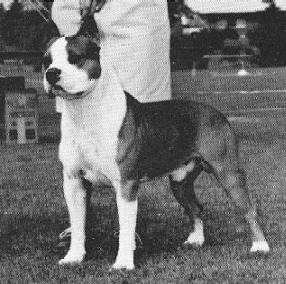
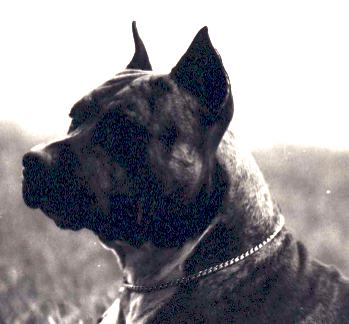
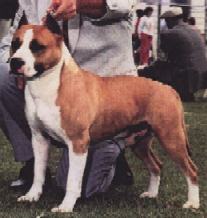
Ch. Tyarr Touch O Class Ch. Sindelar's
Hawk
American Kennel Club History:
To give correctly the origin and history of the American
Staffordshire Terrier, it is necessary to comment briefly on two
other dogs, namely the Bulldog and the terrier.Until the early part
of the 19th century, the Bulldog was bred with great care in England
for the purpose of baiting bulls. The Bulldog of that day was vastly
different from our present-day "sourmug." Pictures from as late as
1870 represent the Bulldog as agile and as standing straight on his
legs--his front legs in particular. In some cases he was even
possessed of a muzzle, and long rat tails were not uncommon. The
Bulldog of that day, with the exception of the head, looked more
like the present-day American Staffordshire Terrier than like the
present-day Bulldog.
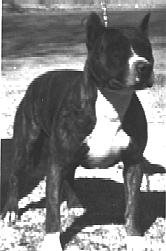

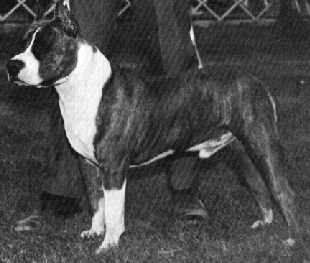
Ch. Tara's Doc Holiday Ch. Ruffian Hercules of Har-Wyn
Some writers contend it was the white English Terrier, or the
Black-and-Tan Terrier, that was used as a cross with the Bulldog
to perfect the Staffordshire Terrier. It seems easier to believe that
any game terrier, such as the Fox Terrier of the early 1800s, was
used in this cross, since some of the foremost authorities on dogs of
that time state that the Black-and-Tan and the white English Terrier
were none too game, but these same authorities go on to stress the
gameness of the Fox Terrier. It is reasonable to believe that
breeders who were attempting to perfect a dog that would combine
the spirit and agility of the terrier with the courage and tenacity of
the Bulldog, would not use a terrier that was not game. In analyzing
the three above-mentioned terriers at that time, we find that there
was not a great deal of difference in body conformation, the greatest
differences being in color, aggressiveness, and spirit. In any event,
it was the cross between the Bulldog and the terrier that resulted in
the Staffordshire Terrier, which was originally called the Bull-and
-Terrier Dog, Half and Half, and at times Pit Dog or Pit Bullterrier.
Later, it assumed the name in England of Staffordshire Bull Terrier.
These dogs began to find their way into America as early as 1870,
where they became known as Pit Dog, Pit Bull Terrier, later
American Bull Terrier, and still later as Yankee Terrier. In 1936,
they were accepted for registration in the American Kennel Club
stud book as Staffordshire Terriers. The name of the breed was
revised effective January 1, 1972 to American Staffordshire Terrier.
Breeders in the USA had developed a type which is heavier in
weight than the Staffordshire Bull Terrier of England and the name
change was to distinguish them as separate breeds.
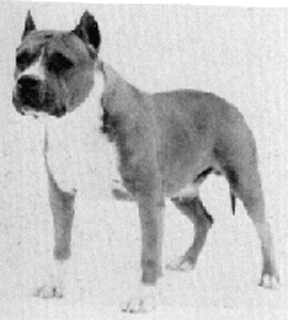
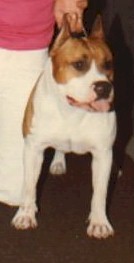
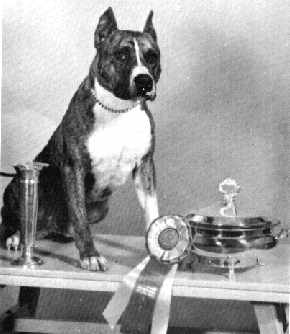
Ch. Tryarr Diamondback Redbolt Ch. Sky King of Har-Wyn
The American Staffordshire Terrier's standard allows a variance in
weight, but it should be in proportion to size. The dog's chief
requisites should be strength unusual for his size, soundness, balance,
a strong powerful head, a well-muscled body, and courage that is
proverbial. To clarify the confusion that may exist, even in the minds
of dog fanciers, as to the difference between the American
Staffordshire Terrier and the Bull Terrier, a comment on the latter
may be helpful.The Bull Terrier was introduced by James Hinks of
Birmingham, who had been experimenting for several years with the
old bull-and-terrier dog, now known as Staffordshire. It is generally
conceded that he used the Staffordshire, crossed with the white
English Terrier, and some writers contend that a dash of Pointer and
Dalmation blood was also used to help perfect the all-white Bull
Terrier.
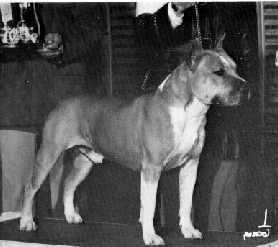
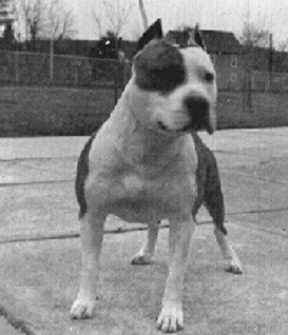
Ch. Sooner's Ranger El Cajohn Ch.Sligo
McCarthy
In mentioning the gameness of the Staffordshire, it is not the
intention to tag him as a fighting machine, or to praise this
characteristic. These points are discussed because they are
necessary in giving the correct origin and history of the breed. The
good qualities of the dogs are many, and it would be difficult for
anyone to overstress them. In appearance, they are flashy -looking
and they attract much attention on the show bench. As to character,
they exceed being dead game; nevertheless, they should not be held
in ill repute merely because man has been taking advantage of this
rare courage to use them in the pit as gambling tools. These dogs are
docile, and with a little training are even tractable around other
dogs. They are intelligent, excellent guardians, and they protect their
masters' property with an air of authority that counts; they easily
discriminate between strangers who mean well and those who do
not. They have another characteristic that is unusual: when they are
sold, or change hands, they accept their new masters in a
comparatively short time.
Standard of the American Staffordshire Terrier:
